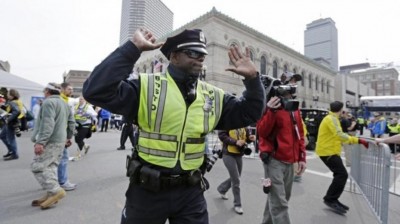Boston Terror Attacks, Bomb Squad, Terror Drill, Bomb Sniffing Dogs, Law Enforcement Spotters, National Guard…
All of America’s Security Forces Were There

Terror Bombing Shows that Our Anti-Terrorism Policies Are Ineffective
We documented earlier today that the American government has squandered huge sums of homeland security and defense spending on useless tasks that increase – rather than prevent -terrorism.
Indeed, the head cross-country track coach at the University of Mobile – Alastair Stevenson – told Alabama’s Press-Register:
“At the starting line this morning, they had bomb sniffing dogs and the bomb squad out there,” he said. “They kept announcing to runners not to be alarmed, that they were running a training exercise.”
He added, “I’ve run a lot of races like this one, but I never saw bomb dogs at the starting line of any running event.
Stevenson provided additional details in an interview by local 15 tv news:
University of Mobile’s Cross Country Coach, who was near the finish line of the Boston Marathon when a series of explosions went off, said he thought it was odd there were bomb sniffing dogs at the start and finish lines.
“They kept making announcements to the participants do not worry, it’s just a training exercise,” Coach Ali Stevenson told Local 15.
Stevenson said he saw law enforcement spotters on the roofs at the start of the race. He’s been in plenty of marathons in Chicago, D.C., Chicago, London and other major metropolitan areas but has never seen that level of security before.
Time Magazine reported yesterday:
Over the years, the Boston Marathon has undergone numerous security overhauls. TIME writer Katy Steinmetz reports: Under heightened security in 2002, 600 police officers joined the runners. There were also an unprecedented 1,500 state and local police patrolling the route and another 1,500 security guards. There were 415 National Guard troops on hand. Helicopters, bomb-sniffing dogs, hazmat teams and radiation detectors were added. Boston Globe compared to security used for the Olympics and Super Bowl. According to the Mass. National Guard website, more than 400 troops were involved in 2013, too. From the release: Pfc. Matthew S. Knowlton, a military policeman with the 747 Military Police Company, was one Soldier assigned to help out at the starting line. Describing the scene Knowlton said, “This is a very positive setting, I’m just happy to be here. There are a lot of people here but it’s a great crowd.”
Indeed, the Massachusetts National Guard release notes:
Sgt. Ezequiel Valencia, a human resources sergeant, with the 747 Military Police Company, Massachusetts Army National Guard, looks on as runners begin the 117th Boston Marathon April 15, 2013 in Hopkinton, Mass. More than 400 Guardsman were on hand to help local law enforcement keep the route clear for an estimated 27,000 runners. (U.S. Army photo by Sgt. 1st Class James C. Lally, Massachusetts National Guard Public Affairs)
In addition, Mother Jones reports:
At 5:20 a.m. on Monday, four hours before the Boston Marathon’s elite runners took off, a group of 15 active-duty soldiers from the Massachusetts National Guard gathered at the starting line in Hopkinson. Each soldier was in full combat uniform and carried a “ruck,” a military backpack weighing about 40 pounds. The rucks were filled with Camelbacks of water, extra uniforms, Gatorade, changes of socks—and first-aid and trauma kits. It was all just supposed to be symbolic.
“Forced marches” or “humps” are a regular part of military training, brisk walking over tough terrain while carrying gear that could help a soldier survive if stranded alone. These soldiers, participating in “Tough Ruck 2013,” were doing the 26 miles of the Boston Marathon to honor comrades killed in Iraq and Afghanistan, or lost to suicide and PTSD-related accidents after coming home.
It took about eight hours for all of the soldiers to cross the finish line, some cruising nearly at a 13-minute mile, others coming in at a little slower pace. They were gathered near the medical tent behind the finish line, waiting for the elite runners to come in. That was the contingency plan in case anything went wrong—meet by the medical tent.
***
A Tough Ruck soldier marching the marathon course Military Friends FoundationWhen the explosion went off, Fiola and his group immediately went into tactical mode. “I did a count and told the younger soldiers to stay put,” Fiola says. “Myself and two other soldiers, my top two guys in my normal unit, crossed the street about 100 yards to the metal scaffoldings holding up the row of flags. We just absolutely annihilated the fence and pulled it back so we could see the victims underneath. The doctors and nurses from the medical tent were on the scene in under a minute. We were pulling burning debris off of people so that the medical personnel could get to them and begin triage.”
“There was a guy behind me covered in his own blood, and I started to smell some smoke. I turn around to look and he’s actually on fire.”
Once the victims were transported away for further medical care, Fiola and the others stood guard around the blast area. “We switched to keeping the scene safe, quarantining the area and preventing people from entering. There was a guy behind me covered, just covered, in his own blood, and I started to smell some smoke.
***
The ruckers at 5 a.m., before setting off on the course Military Friends Foundation
As one of our readers notes:
All of America’s security forces were there. Spotters. Bomb sniffing dogs. The whole array. They even ran a drill beforehand.
Comparisons to 9/11 are inevitable.




